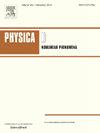Vegetation pattern formation and transition in dryland ecosystems with finite soil resources and inertia
IF 2.7
3区 数学
Q1 MATHEMATICS, APPLIED
引用次数: 0
Abstract
The formation of vegetation patterns in dryland ecosystems and the transition between different morphologies are here investigated by means of a bidimensional hyperbolic reaction-transport model. The proposed conceptual framework represents an extension of the classical Klausmeier model in which the finite carrying capacity of the soil and the inertia of biomass and water are also taken into account. The main aim of this work is to elucidate how pattern dynamics occurring at, near and far from the instability threshold are affected by the combined action of limited soil resources, inertia and climate change. To achieve this goal, a threefold investigation is carried out. First, linear stability analysis is addressed to deduce the main pattern features associated with Turing patterns at the onset of instability. Then, multiple-scale weakly nonlinear analysis is employed to characterize the pattern amplitude close to onset. In particular, the study encompasses the description of different pattern morphologies which emerge when the excited eigenmode exhibits single or double multiplicity. Finally, the transition between different patterned states is investigated in far-from-equilibrium conditions, especially to emphasize the nontrivial role played by inertia in the ecosystem response. Numerical simulations are also used to corroborate analytical predictions and to shed light on some key aspects of vegetation pattern dynamics in the context of dryland ecology.
有限土壤资源和惯性条件下旱地生态系统植被格局的形成与转变
本文利用二维双曲反应-传输模型研究了旱地生态系统植被格局的形成和不同形态之间的过渡。提出的概念框架代表了经典Klausmeier模型的扩展,其中土壤的有限承载能力和生物量和水的惯性也被考虑在内。本工作的主要目的是阐明在不稳定阈值附近和远离不稳定阈值的格局动力学如何受到有限土壤资源、惯性和气候变化的共同作用。为了实现这一目标,进行了三重调查。首先,进行线性稳定性分析,以推导出与图灵模式相关的主要模式特征。然后,采用多尺度弱非线性分析来表征接近起始点的模式幅值。特别是,该研究包含了当激发本征模表现出单或双多重性时出现的不同模式形态的描述。最后,在远离平衡的条件下,研究了不同模式状态之间的转换,特别强调了惯性在生态系统响应中所起的重要作用。数值模拟还用于证实分析预测,并阐明旱地生态背景下植被格局动态的一些关键方面。
本文章由计算机程序翻译,如有差异,请以英文原文为准。
求助全文
约1分钟内获得全文
求助全文
来源期刊

Physica D: Nonlinear Phenomena
物理-物理:数学物理
CiteScore
7.30
自引率
7.50%
发文量
213
审稿时长
65 days
期刊介绍:
Physica D (Nonlinear Phenomena) publishes research and review articles reporting on experimental and theoretical works, techniques and ideas that advance the understanding of nonlinear phenomena. Topics encompass wave motion in physical, chemical and biological systems; physical or biological phenomena governed by nonlinear field equations, including hydrodynamics and turbulence; pattern formation and cooperative phenomena; instability, bifurcations, chaos, and space-time disorder; integrable/Hamiltonian systems; asymptotic analysis and, more generally, mathematical methods for nonlinear systems.
 求助内容:
求助内容: 应助结果提醒方式:
应助结果提醒方式:


